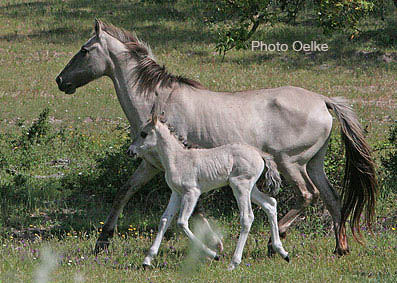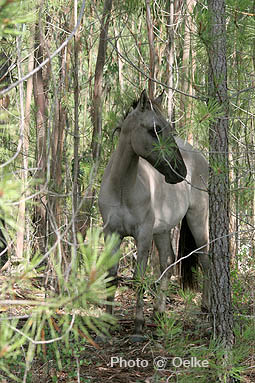BREED OR SUBSPECIES?


Wild Sorraia mares and foal in the Vale de Zebro Refuge
BREED OR SUBSPECIES? — THE ZOOLOGIST'S DEFINITION
The main reason why the Portuguese do not preserve the Sorraia as a wild horse is that they view it as a breed, now that they have at least become aware of its existence. So what is a breed, what is a species, and what is a subspecies?
According to the Oklahoma's State University's department of animal science, the term "breed" is usually defined like this:
"Animals that, through selection and breeding, have come to resemble one another and pass those traits uniformly to their offspring".
Jay L. Lush in "The Genetics of Populations" offers this definition:
"A breed is a group of domestic animals, termed such by common consent of the breeders, … a term which arose among breeders of livestock, created, one might say, for their own use, and no one is warranted in assigning to this word a scientific definition and in calling the breeders wrong when they deviate from the formulated definition. It is their word, and the breeders common usage is what we must accept as the correct definition".
Lush is making a significant point here by linking the term "breed" to domestic animals. Besides the fact that a breed has an accepted standard of perfection, the term "breed" can be applied only for domestic animals (and plants), it means that this population of animals share common characteristics because Man has selected and bred for them.
The term "species" refers to wild and domestic animals, i. e. wild animals and their domestic derivatives, as far as they exist. In the horse, we do have domestic derivatives of the ancestral wild horses. It is important to note that they all belong to one and the same species.
So, what constitutes a species?
According to Herre*), animals belong to one and the same species if they constitute a reproductive unit, i. e. mate voluntarily and, in doing so, reproduce with unlimited fertility. Even if they differ considerably in phenotype, they do belong to one and the same species as long as they belong to one reproductive unity.
This definition of a species has been established a long time ago.
The Biological Species Concept (BSC) of MAYR (1942), which is widely accepted in the scientific community, defines species as follows:
"Individuals of different species do not interbreed under natural conditions".
Zoologist and geneticist Thomas Jansen explains:
"This means that fertility or sterility of the offspring can be an indicator whether or not the parents belong to one species, but this is no necessary prerequisite. 'Natural conditions' means more: pre-mating factors such as different ethological mechanisms, for example different courtship displays, which will prevent mating of two individuals of different species in the wild. One example are donkeys and horses: Mules and hinnies (as a product of crossbreeding in captivity) are well known, and they are not always sterile. But a horse and a donkey will never mate in the wild because of their very different courtship displays. They belong to different species, no one can seriously cast doubt on that."
Within a species, one can often find populations which differ considerably in phenotype, behavior, etc., and which pass on their characteristics reliably to their offspring. Such a population is considered a "subspecies", or "race", and within those, one can have "variants".
All existing horses today will interbreed freely, voluntarily, and with unlimited fertility, which means that they all belong to one and the same species. They may be wild or they may stem from a domestic breed—they all belong to the same species.
The various wild ancestors of today's horses, as different as they were in phenotype, size, and behavior, were subspecies within the one species.
Other equids, e. g. Equus asinus, the ass or donkey, are related to the horse closely enough to even make bastardization possible, but such crosses only occur through human intervention. Horses and asses don't mate voluntarily, at least not if they have the choice of a mate of their own species. Therefore, horses and asses represent different species, as do hemiones ("half-asses"), and the three zebra species.
Thomas Jansen, regarding the question of Mongolian wild horse and domestic horse belonging to separate species, explains:
"If some people claim that the Mongolian wild (Przewalski's) horse is another species than the domestic horse, then this is in fact not true. Future research may indicate that the Mongolian wild horse is possibly in the process of forming its own species (in some ten thousand years or so). However, today the Mongolian wild horse and the domestic horse belong to the same species, as they interbreed under natural conditions, and with unrestricted fertility. The only conclusion is: One may define the Mongolian wild horse as a subspecies. It is a horse and nothing else.
Another example is the relationship between wolf and dog. The argumentation would be the same: Wolves and dogs interbreed under natural conditions and produce fertile offspring. Therefore, they belong to one species."
Zoologist Rainer Willmann points out**) that species are separated as such due to the absence of an interchange of genes:
"Reproductive isolation means absence of gene flow from one population into another due to biological mechanisms. This means, strictly speaking, that all members of such unit—species—cannot, under natural conditions, have fertile descendants with members of another species. They are 'genetically separated' from one another."
In contrast to other definitions of the term "species", which lack objectivity, Willmann goes on to say:
"Because reproductive isolation is a real, naturally developed phenomenon dividing the organic diversity, the classification based on this order is also real. Biospecies are therefore real units of nature."
As has been mentioned, subspecies may be found within a species. They belong to the same biological, reproductive unit, but can be recognized and classified due to different phenotypical and behavioral characteristics, and—with modern moleculargenetic methods—by genotype.
"A subspecies can be defined as 'something like a natural race', or variety, which is in most cases founded by geographical separation", says Jansen. "The Mongolian wild horse is not the forefather of our domestic horses, but it is also not another species. As it is easily recognized due to specific phenotypical traits (and, by the way, also by its unique genetic patterns), it can only be named a subspecies."
Back to the Sorraia horses: Ruy d'Andrade did never refer to them as "feral" horses***), which would have meant that they were domestic horses that at some point had reverted to a wild state. He considered the Sorraias to be direct descendants of a true wild horse, of a primeval subspecies, or race. He never claimed that they were still pure, but he hoped to breed them back to near purity by keeping them isolated on his estate and in their natural environment.

Sorraia yearling colt in the Vale de Zebro, hiding in the trees after he got kicked out of the family band. He and another one led a solitary existence, but the next generation of colts formed a bachelor band, as is most common with male wild horses that do not have a harem
Again, there is the Sorraia's old genetic type, its primitive phenotype and its wild behavior, and there is the fact that the Sorraia has no history as a domestic breed. All this suggests that the remaining Sorraias are a remnant population of a true wild horse form, i. e. a subspecies.
If Sorraias don't exist in the wild anymore, if they have been bred in captivity for decades now, if their data is recorded in a studbook in Portugal, if they are bred by some owners like a domestic breed, then all that does not take away from the fact that their origin is not that of a domestic breed, that they in all probability do represent a subspecies. After all, what happened to the Sorraia horse has also happened to Przewalski's horse even to a more severe degree: It survived only in captivity, in a domestic situation, was bred in zoos for a century, and has a world-wide studbook—yet still nobody says it is a breed, although their breeding history in captivity is longer than the Sorraia's. The few Przewalski horses roaming wild in the desert of Central Asia now were re-introduced, they were bred in domestication, or stem from animals bred in domestication. By comparison, Sorraias have survived under semi-wild conditions, while Przewalski's horses for many generations survived only in the unnatural environment of zoo's enclosures.
How could the Sorraia horse's status as a true wild subspecies be proven? It is impossible to prove a wild status for any animal; it‘s therefore also impossible to do so for the Sorraias. However, it is equally difficult to prove the opposite! The question is: What kind of evidence would one consider proof? Beside the Mongolian wild horse (Przewalski's horse), the Tarpan's status as a wild subspecies is recognized by many zoologists, if not most, and the results of mitochondrial DNA research so far indicate that the Tarpan and the Sorraia are of the same genotype. If further research confirms this then it stands to reason that Sorraias are an Iberian regional variant of the Tarpan, a remnant of an Iberian Tarpan population.
In summary, it is fair to say that what we have in the way of evidence clearly points one way: that Sorraias are primitive horses, a subspecies.
*) Herre, "Grundsätzliches zur Systematik des Pferdes", 1961, Zeitschrift für Tierzüchtung und Züchtungsbiologie
**) Willmann, "Die Art als Taxon und als Einheit der Natur", 1992, Entomol. Blätter, Bd. 88
***) d'Andrade, "O Cavalo do Sorraia", 1945, Boletim Pecuario, XIII; "Apontamentos para um estudo sobre a origem e domesticação do cavallo na Peninsula Hiberica, Aproximações", 1926, Lisboa; "Alrededor del Caballo Español"; "Les Chevaux du Sorraia", 1935, Extrait des comptes rendus du XIIe Congrès International de Zoologie, Lisboa, "Elements pour une classification des Équidés actuels, d'après leurs caractères craniologiques et dentaires", 1937, Bulletin de la Société Portugaise des Sciences Naturelles



